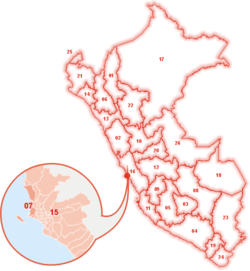Lima
Lima is the capital city (where the government works), and is considered the most important and largest city of Peru. 75% of the Peruvian economy is handled in Lima. Lima is the industrial and financial center of Peru, and one of the most important financial centers in Latin America.
Lima | |
|---|---|
|
| |
| Nickname(s): La Ciudad de los Reyes (The City of Kings) La Tres Veces Coronada de Villa (The Three Times Crowned Villa) La Perla del Pacífico (The Pearl of the Pacific) Lima La Gris (Lima the grey) | |
 Location within Lima Province | |
| Coordinates: 12°2′36″S 77°1′42″W / 12.04333°S 77.02833°W | |
| Country | Peru |
| Province | Lima Province |
| Established | January 18, 1535 |
| Founded by | Francisco Pizarro |
| Government | |
| • Mayor | Rafael López Aliaga (2023-) |
| Area | |
| • City | 2,672.3 km2 (1,031.8 sq mi) |
| • Urban | 800 km2 (300 sq mi) |
| • Metro | 2,819.3 km2 (1,088.5 sq mi) |
| Elevation | 0−1,550 m (0−5,090 ft) |
| Population (2017)[2] | |
| • Urban | 9,752,000 |
| • Urban density | 12,000/km2 (32,000/sq mi) |
| • Metro | 12,140,000 |
| Demonym(s) | Limeño (Male) Limeña (Female) |
| Time zone | UTC−5 (PET) |
| Website | Official Website |
It is an important city of South America and the entrance to Peru. Lima is city in constant urban growth. It has a large population. Over 8 million people live in the metropolitan area, which includes Callao Seaport. Lima is the fifth largest city in Latin America, behind Mexico City, São Paulo, Buenos Aires and Rio de Janeiro.
The city was founded by the Spanish conquistador (conqueror) Francisco Pizarro on January 18, 1535. He called it 'La Ciudad de los Reyes' (the City of the Kings). It became the capital and most important city in the Spanish Viceroyalty of Perú. And after the Peruvian War of Independence, it became the capital of the Republic of Peru.
In the 1940s, Lima started a period of rapid growth, with the migration from the Andean regions of Peru, as rural people. They wanted to find better opportunities for work and education. The population, estimated at 0.6 million in 1940, reached 1.9M by 1960 and 4.8M by 1980.
Lima has developed an important tourism industry, characterized by its historic center, archeological sites, nightlife, museums, art galleries, festivals, popular traditions, and gastronomy. Lima is considered Americas's gastronomical capital.
Lima is made up of mainly Spanish speaking inhabitants with over 90% of the population speaking the language. Lima Province has 43 districts, including:
1 - Cercado de Lima
3 - Ate
4 - Barranco
5 - Brena
7 - Comas
9 - Chorrillos
10 - El Agustino
11 - Jesus Maria
12 - La Molina
13 - La Victoria
14 - Lince
17 - Magdalena del Mar
18 - Miraflores
21 - Pueblo Libre
22 - Puente Piedra
25 - Rimac
27 - San Isidro
28 - Independence
29 - San Juan de Miraflores
30 - San Luis
31 - San Martin de Porres
32 - San Miguel
33 - Santiago de Surco
34 - Surquillo
35 - Villa María del Triunfo
36 - San Juan de Lurigancho
38 - Santa Rosa
39 - Los Olivos
41 - San Borja
42 - Villa El Savador
43 - Santa Anita
References
change- ↑ "Peru Altitude". Archived from the original on 2020-10-29. Retrieved 2014-07-28.
- ↑ "INEI: Lima cuenta con 9 millones 752 mil habitantes". larepublica.pe. Archived from the original on 2016-03-25. Retrieved 2018-05-18.




